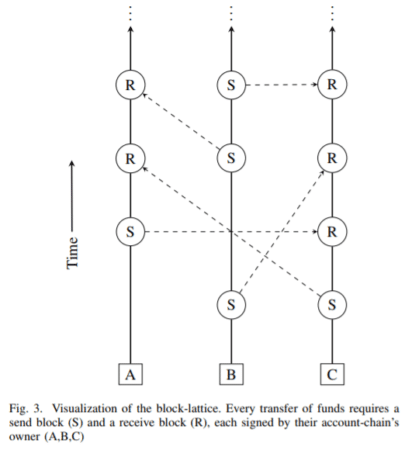Nano Block Lattice Explained
Last Updated: 1st November 2018
A block lattice is a novel type of DAG (Directed Acyclic Graph) based architecture that was first introduced by the Nano cryptocurrency. With this type of architecture, each individual transacting on the network possesses their own blockchain, which is controlled by the individual’s private keys. The block lattice architecture is designed to be an improvement upon the current blockchain model that is currently being used by cryptocurrencies such as Bitcoin. The block lattice accomplishes this by allowing for faster transaction times than are currently being achieved with blockchain models.
One feature of the block lattice design, which enables faster transaction times, is that each user’s blockchain tracks their account balance, rather than their transaction amounts. This method allows for less intensive storage requirements by means of database pruning. Additionally, each blockchain that is controlled by a user will also reflect information related to the individual’s balance history and can only be updated by the owner.
Another important feature of the Nano block lattice is that a user’s blockchain can be updated asynchronously to the rest of the block lattice. Because each user possesses total control over their own blockchain, distributed consensus protocols such as proof-of-work (PoW) or proof-of-stake (PoS), that are used to achieve consensus as to the shared global state of the ledger, are not needed. This has a significant impact on the speed with which transactions can be processed, because the entire network no longer has to process every single transaction that is made. Instead, with the block lattice architecture, each user possesses their own blockchain that operates asynchronously to every other blockchain. This transforms a shared data structure i.e. a shared global ledger, which can be found in Bitcoin, into a set of non-shared asynchronous ledgers, which has the advantage of producing faster transaction times.
Transferring funds using Nano’s block lattice model results in two separate transactions. Balances are transferred between users’ blockchains through send and receive blocks. A send transaction will deduct funds from a sender’s balance, whilst a receive transaction will add funds to a receiving account’s balance.
Blockchain Scalability
One significant problem that blockchains currently face is that, in their current form, they do not scale. For example, the Bitcoin blockchain is only able to process approximately 7 transactions per second. This is in contrast to existing centralized payment systems such as VISA, who have the capacity to process roughly 2000 transactions per second. Thus, numerous solutions have been proposed in addressing blockchain scalability. One such proposal is to implement second layer scaling solutions to blockchain. These second layer scaling solutions include, for example, the lightning network for Bitcoin, or the Raiden Network in the case of Ethereum. Other proposals to deal with blockchain scalability issues have been to completely remove blockchains themselves. The reason being that the blockchain architecture is an inherently unscalable one. Each block in a blockchain can only store a limited amount of data, and also the average confirmation time for a Bitcoin block confirmation can be quite lengthy.
The limitations of the blockchain has prompted the implementation of DAG based models such as Nano’s block lattice. This novel architecture is designed not only to achieve decentralized peer-to-peer payment, but to do so in an incredibly rapid manner.





